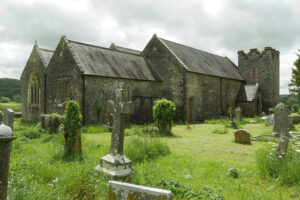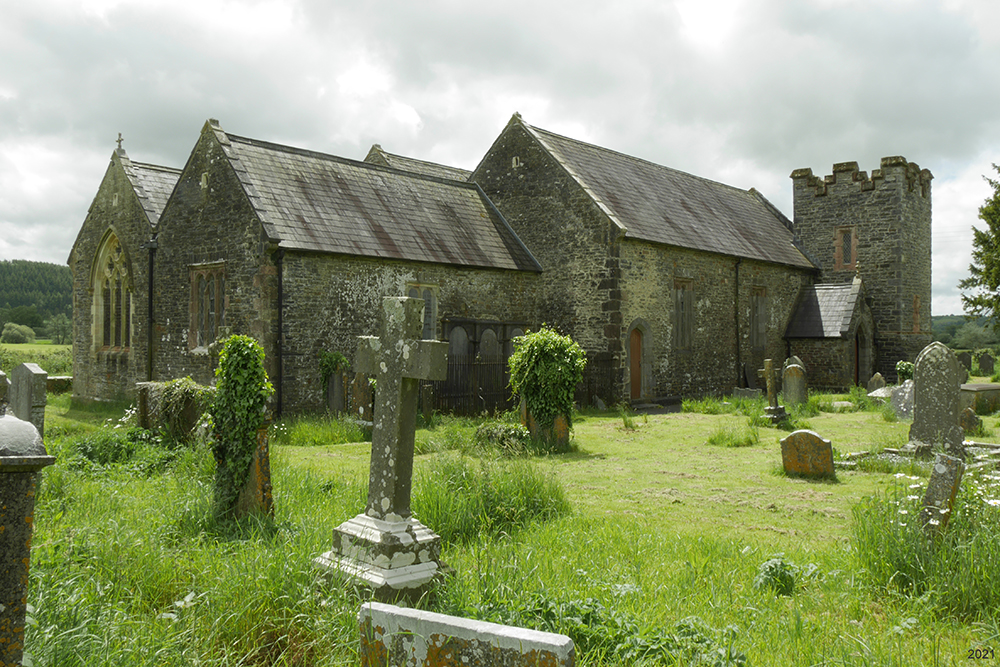
ST EGWAD,
LLANEGWAD,
CARMARTHENSHIRE (DINEFWR)
Dyfed PRN 17392
RB No. 3453
NGR SN 5193 2132
Not listed (1998)
Listed Building No.: 21461.
Listed Grade II. First Listed in 1999. Last Amended in 2003.
Reason for Listing: Listed as a C19 parish church of definite quality and character, with good interior detail, and for its contribution to the overall historic integrity of this small village.
SUMMARY
19th century church; 0% medieval core fabric. On site of, and in same location as, medieval church (Dyfed PRN 7370).
A multicell church, large. Consists of chancel, 2 bays; nave, 4 bays; north chapel, 2 bays; north aisle, 4 bays; north porch; all 1849. North-west tower, 3 storeys, 1902. Coalhouse and boilerhouse (south of chancel), early-mid 20th century. Construction is mainly in squared and coursed limestone rubble, with some 20th century brick; the south wall is partly rendered and the interior is plastered. Openings are mainly from 1849 and neo-Perpendicular, with ORS dressings partly rebuilt in 1902 in grey oolite. Slate gable roofs; coalhouse and boilerhouse with asbestos lean-to roofs; tower with a timber ‘spire’.
Roofs and floors: Mainly 1849 and 1902. Finishes: 1849 – 1948.
Condition – good.
Archaeological potential – good. No external drain or cutting around church; below-ground floor in 5% of church; suspended floors over a void in 50% of church; external memorial significantly close to 5% of church.
Structural value (pre 19th century) – poor. 0% pre-1849 core fabric.
Group value – low-medium. C19 landmark church in centre of village; large churchyard; lych-gate; inscribed stone (?).
Phasing:
Phase 1 – Chancel, nave, north chapel, north aisle, north porch, 1849.
Phase 2 – North-west tower, 1902.
DESCRIPTION
St Egwad, Llanegwad, is multicelled church, of large size. It was entirely (re)built in 1849, on the same site, and in the same location as its predecessor, but retaining nothing from the earlier fabric.
The present church consists of a 2-bayed chancel, a 4-bayed nave, a 2-bayed north chapel, a 4-bayed north aisle, a north porch, a 3-storeyed tower built against the north-west corner of the aisle, and a coalhouse and a boilerhouse south of the chancel. Construction is mainly in roughly squared and coursed limestone rubble; the nave south wall is rendered, from 1948?, and the interior is plastered. Openings are neo-Perpendicular, and except in the tower are from c.1849; windows are mainly 2-light with Old Red Sandstone dressings, but some were rebuilt in 1902 in grey oolite. The north-west tower is square, crenellated, with similar openings from 1902. The coalhouse and boilerhouse are in brick. The roofs are slated gables; the coalhouse and boilerhouse have lean-to asbestos sheet roofs and the tower carries a timber ‘spire’.
Nothing remains from the earlier church, which appears, with the exception of the tower, to have followed the same general plan form with chancel, nave, and north aisle, the latter having been reroofed in 1788 (Carms. R. O., CPR/103/17); the tithe map shows a simple rectangle (NLW, Llanegwad, 1839). Something more substantial than a bellcote lay at the west end, but of unknown form; in 1717 it was described as ‘our steeple (if it be so called)’, and was in ‘good order, according to the form it was first built’ (Evans, 1921 (ii), 2). The floor was still unflagged in 1790 (Evans, 1922, 56). In 1848, there was room for 112 sittings (Carms. R. O., CPR/103/31).
The church was entirely rebuilt ‘and enlarged’ in 1849, to the designs of the architect John Harries of Llandeilo (Carms. R. O., CPR/103/31), to accommodate 312 sittings.
The north-west tower was added in 1902 (NLW, SD/F/310), but the 2 pre-Reformation bells were retained (Lewis, 1925, 389); they date from c.1500 and bear the inscriptions ‘NOS REGAT HIIS ANNIS SANCTA FGIURA IOHANNIS’, and ‘ORA PRO NOBIS SA’CTA MARIA’ (RCAHM, 1917, 117).
The coalhouse and boilerhouse were added in the early-mid 20th century.
The church was renovated, and the internal plaster entirely stripped, in 1948 (Brunker, 1961, 3). It was replastered; the nave south wall may have received its render at the same time.
The font is modern.
An inscribed stone (inscription? date?) was found during the 1940s renovation within the south wall (Brunker, 1961, 3).
There is neither an external drain nor a cutting around the church. The boilerhouse floor is below churchyard ground level. Floors are suspended above a void in the nave and north aisle. An external burial vault lies against the north chapel north wall.
The church was not listed in 1998. Listed Grade II. First Listed in 1999. Last Amended in 2003.
SITE HISTORY
There is some evidence for the pre-conquest religious use of the site –
Celtic dedication.
St Egwad, Llanegwad, was a parish church during the post-conquest period (Rees, 1932) of the medieval Deanery of Stradtowy. It was appropriated to the Premonstratensian Abbey at Talley by Bishop Gervase of St Davids, previously Abbot of Talley, in 1215 (Owen, 1894, 227); in 1291 it was valued at £6 13 4d, and in 1536 at £13 6s 8d. There were at least 3 chapels-of-ease within the parish (Price, 1879, 171) but there may have been more ie. one for each township.
After the dissolution, the patronage fell to the Bishops of St Davids, and in 1833 the living, a vicarage in the patronage of the Bishop, was rated in the king’s books at £8 13s 4d (Lewis, 1833).
In 1998 St Egwad, Llanegwad, was a parish church. The living was a vicarage, held with Llanfynydd (Benefice no. 677) in the Archdeaconry of Carmarthen, Rural Deanery of Llangadog and Llandeilo (St Davids, 1997-8).
According to local tradition the original chapel of St Egwad stood ‘in a filed close to the site of the present church’, and was turned into a dwelling house during the 18th century (Sambrook and Page, 1995 (ii), 59), but the village morphology suggests that the present churchyard has a long history of use.
SOURCES CONSULTED
Map Evidence
NLW, Ordnance Survey 1:2500, First Edition, Sheet XL.2.
NLW, Ordnance Survey 1:2500, Second Edition, Sheet XL.2.
NLW, Parish of Llanegwad, Tithe Map, 1839.
Rees, W., 1932, South Wales and the Border in the XIVth century.
Church in Wales Records
St Davids, 1997-8, Diocesan Year Book.
NLW, SD/F/310, Faculty – Erection of tower with a peal of bells, 1902.
NLW, SD/F/311, Faculty – Stained glass window, 1930.
NLW, SD/F/312, Faculty – Brass eagle lectern, 1930.
Parish Records, Carmarthenshire Record Office, Carmarthen
CPR/103 – Llanegwad:-
CPR/103/16 – Vestry Minute Book, 1704-1775.
CPR/103/17 – Vestry Minute Book, 1788-1789.
CPR/103/22 – Copies of Parish Register Entries, 1753-c.1782.
CPR/103/23 – Correspondence from Public Works Loan Office, 1848-1866.
CPR/103/31 – Notice of Rebuilding of Church, n.d., c.1849.
Unpublished Accounts
Sambrook, R. P., and Page, N. A., 1995 (i), The Historic Settlements of Dinefwr (Unpublished client report; copy held with Dyfed SMR).
Sambrook, R. P., and Page, N. A., 1995 (ii), The Historic Settlements of Dinefwr: Gazetteer (Unpublished client report; copy held with Dyfed SMR).
Printed Accounts
Anon., 1917, ‘Reviews and Notices’, Archaeol. Cambrensis, Vol. XVII, Sixth Series.
Brunker, J., 1961, ‘Llanegwad Inscribed Stone’, The Carmarthenshire Antiquary Vol. III.
Crossley, F. H., and Ridgway, M. H., 1947, ‘Screens, Lofts and Stalls situated in Wales and Monmouthshire: Part 8’, Archaeol. Cambrensis, Vol. XCIX.
Evans, G. E., 1917, ‘Churchwardens’ Presentments, AD 1705’, Transactions of the Carmarthenshire Antiquarian Society Vol. 11.
Evans, G. E., 1918, ‘Llanegwad, 1749’, Transactions of the Carmarthenshire Antiquarian Society Vol. 12.
Evans, G. E., 1921 (i), ‘Church Items, 1739-1820’, Transactions of the Carmarthenshire Antiquarian Society Vol. 14.
Evans, G. E., 1921 (ii), ‘Llanegwad, AD 1717’, Transactions of the Carmarthenshire Antiquarian Society Vol. 14.
Evans, G. E., 1922, ‘Churchwardens’ Presentments, AD 1790’, Transactions of the Carmarthenshire Antiquarian Society Vol. 15.
Jones, J. F., 1957, ‘Llanegwad Inscribed Stone’, The Carmarthenshire Antiquary Vol. II.
Lewis, H., 1925, ‘Welsh Church Bells’, Archaeol. Cambrensis, Vol. LXXX, Seventh Series.
Lewis, S., 1833, A Topographical Dictionary of Wales.
Owen, E., 1894, ‘The History of the Premonstratensian Abbey of Talley, Part 2’, Archaeol. Cambrensis Vol. XI, Fifth Series.
Price, D. L., 1879, ‘Talley Abbey, Carmarthenshire’, Archaeol. Cambrensis Vol. X, Fourth Series.
RCAHM, 1917, Inventory: Carmarthenshire.
Salter, M., 1994, The Old Parish Churches of South West Wales.
Yates, W. N., 1973, ‘The Age of Saints in Carmarthenshire’, The Carmarthenshire Antiquary Vol. IX.
Updated: August 2021 – PKR


